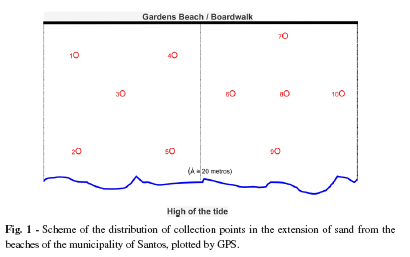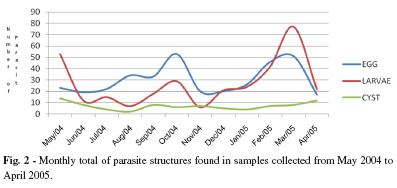The environmental contamination by geohelminths represents a world public health problem and has been well documented by several authors. However, few papers describe the presence of such contamination in saline soils of coastal beaches. A study was performed on the beaches of the municipality of Santos in the period between May 2004 to April 2005 with the aim of determining the degree of contamination, and the correlation between contamination level and seasonal conditions and characteristics of the environment. Of the 2,520 samples analyzed, 18.2% (458) were contaminated, 32.3% (148) of which were localized in children's recreational areas (playgrounds). The parasite profile found in the analyzed samples indicated the presence of several zoonotic parasites: Ancylostoma larvae (82.5%), Toxocara sp. eggs (59.4%), Ancylostomidae-like eggs (37.1%), coccid oocysts (13.5%), Trichostrongylus sp. eggs and larvae, Ascaris lumbricoides eggs, (11.6%), Entamoeba sp. cysts (10.0%), Strongyloides sp. (4.8%), several free nematoids and some non-identified parasitic structures (3.3%). It was established that the highest frequency of parasitic structures occurred in the months between May and October 2004, and from February to March 2005. An increase in the diversity of parasitic forms was documented in the months between February to December 2004 and from January to April 2005, these periods having the highest rainfall.
Larva migrans; Toxocariasis; Sandy soil; Beaches






